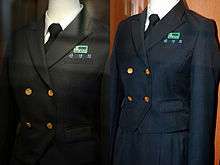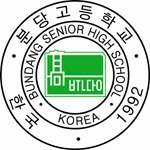Bundang High School
| Bundang High School | |
|---|---|
|
Bundang Standing Proud | |
| Location | |
|
Bundang, Seongnam, Gyeonggi | |
| Information | |
| Type | Public |
| Established | 1992 |
| Faculty | 80 (as of 2015) |
| Grades | 10–12 |
| Number of students | 1,297 (as of 2010) |
| Campus | Urban, 26,800 square metres (6.62 acres) |
| Tree | Gingko biloba |
| Flower | Forsythia |
| Color(s) |
Green, Silver, and White |
| Affiliations |
SOE GEPIK[1] GAOG[2] |
| Website | www.bundang.hs.kr |
Bundang Senior High School (Korean: 분당고등학교, Hanja: 盆唐高等學校), commonly referred to as Bundang High School, is a co-educational, comprehensive,[3] community high school located in Bundang, Korea as part of the Seongnam public schools.
As of the 2015 school year, the school has an enrollment of 1,297 students and 80 classroom teachers (for a student-teacher ratio of 16.2[4]). Prior to 2005, the school was ranked second in selectivity among its fifteen peer schools[5] (district metrics were abolished that year and school admission reorganized into a lottery in accordance with the elimination of the high school entrance exams).[6]
Location
Bundang High School is situated near the Tancheon tributary, in Sunae (neighborhood), Bundang (district), Seongnam (city), Gyeonggi (province), 330 meters southeast of Sunae Station on the Bundang Line (yellow line), and 500 meters west-southwest of Bundang Central Park. The school is 20 kilometers southeast of downtown Seoul.
Facilities
Academic

The academic effort consists of forty classrooms; a library; two computer labs; a computing center; a foreign language lab; a science seminar room; a general classroom; and three self-study library attachments.
Administrative
The administrative and staff-support effort consist of three personnel offices; six teacher offices; two radio broadcast rooms; a publishing center; a media-conference room; four conference rooms; a parent's conference room; a nurse’s ward; and a performance stage.
Athletic
The health and recreation effort consists of a 9,600 square-meter gymnasium; a golf-serving range; a hard-pack gravel pitch. The gymnasium space is convertible to accommodate basketball, volleyball, badminton, Taekwondo, and gymnastics.
Schedule
The school year begins in the first week of March and continues to the last week of December, recessing for one-month in mid-July. Classes are 8:20 to 17:10 Monday to Friday, 8:20 to 11:30 Saturday (odd-weekly). Weekday mandatory self-study is 18:00-21:00 following the 17:10-18:00 dinner break.
Curricula
Bundang offers a challenging curriculum coupled with extensive opportunities in after-school programs, the arts, athletics, and twenty-one student-interest groups. The final two years of education students concentrate their coursework within the social sciences (인문사회) or sciences (자연과학) option. Approximately 60 percent of students follow the social sciences option, 40 percent the sciences.
Self-study is supported by the school until midnight every day.
The school's yearly magazine, the Bundang Post, is student run and entirely written in the English language.
School Seal

The seal was adopted before the first school assembly in January 1992. The emblem's margin is formed by the superposition of the Korean "ㅂ" onto "ㄷ" (apocryphally shaped like a folder). The left "ladder" is but in fact the Chinese character 高 (고, high); the character deliberately stops above the top margin, which education promoters added to signify the school's height above the other area schools. The phonetic inscription ㅂㅜㄴㄷㅏㅇ fills the lower-right in block letters. The emblem is sealed by the bi-lingual incorporated fide: 분당고등학교 / 한국 / 1992 (Bundang Godeung Hakgyo / Hanguk / 1992). Green symbolizes youth, bravery, and a pioneering spirit; silver symbolizes diligence, justice, and harmony; white symbolizes purity, peace, and intelligence.


University Admission
Despite district realignment in 2005, Bundang matriculates students each year to all three SKY universities, to pre-medical and pre-dentistry programs (의치계열), and to the most selective teachers college (교대). For 2005-2010 the school graduated a total of fifteen students to KAIST, Postech, the military academy (사관학교), and Japan's top engineering programs (일본공대).[7]
Sister School
Naemyeon High School, Hongcheon, Gangwon-do (1999)
Notes
- ↑ The Gyeonggi-do English Program in Korea (GEPIK) is a division of EPIK
- ↑ Gyeonggi-do Affiliated Organization for the Gifted (경기도 교육청 지역공동 영재학급).
- ↑ Magnet school prior to the 2005 Seongnam school district realignment of its high schools.
- ↑ (Korean) Bundang High School Homepage -> 학교 소개 -> 학교 현황.
- ↑ Seongnam Office of Education public high school listing. Retrieved 4 May 2009.
- ↑ (Korean) 성남시 분당구 고교 평준화. Retrieved 6 May 2009.
- ↑ 3학년 학부모총회 자료집. 2010 대학입학 합격 전략집. 분당고등학교.
See also
- Bundang
- Bundang HS Debating Club
- Education in Korea
- Korean-version Wiki (Korean)
- Seongnam Office of Education
